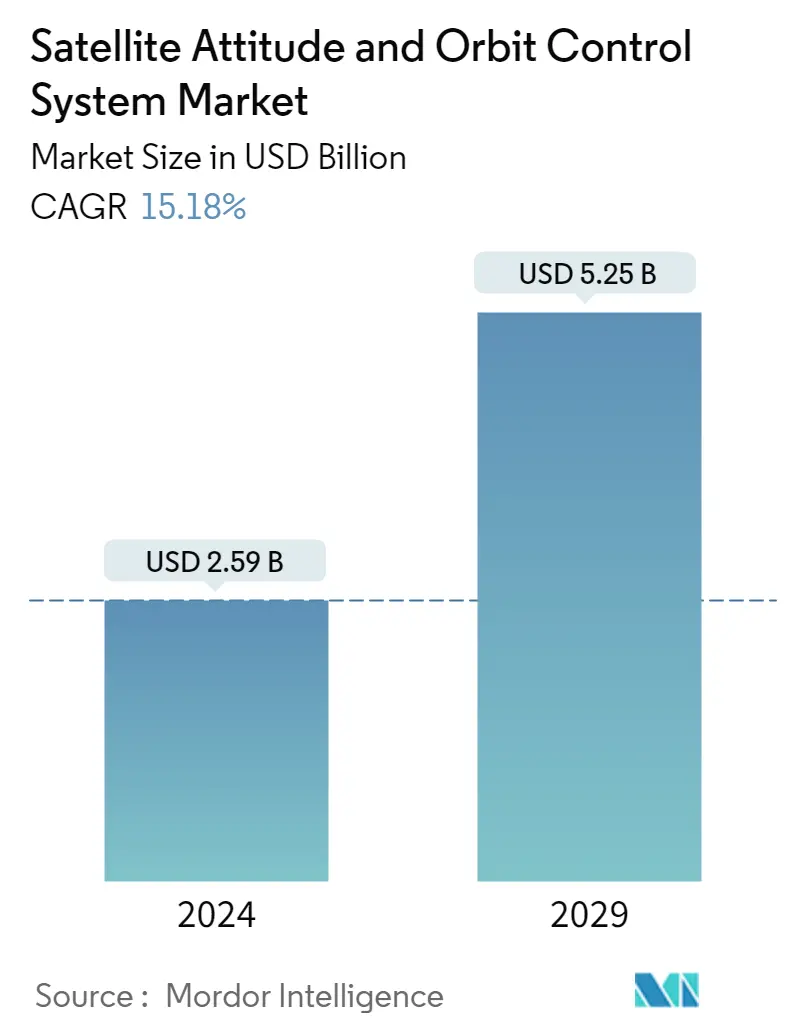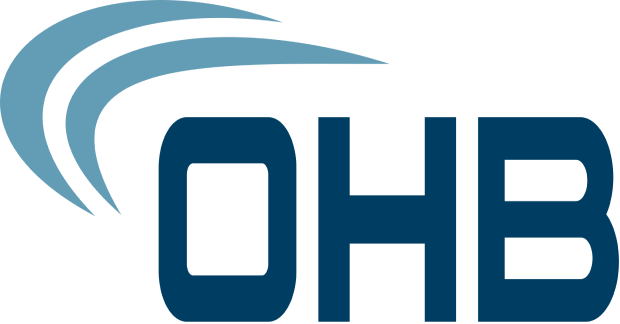Market Size of satellite attitude and orbit control system Industry

|
|
Study Period | 2017 - 2029 |
|
|
Market Size (2024) | USD 2.59 Billion |
|
|
Market Size (2029) | USD 5.25 Billion |
|
|
Largest Share by Orbit Class | LEO |
|
|
CAGR (2024 - 2029) | 15.18 % |
|
|
Largest Share by Region | North America |
Major Players |
||

|
||
|
*Disclaimer: Major Players sorted in no particular order |
Satellite Attitude and Orbit Control System Market Analysis
The Satellite Attitude and Orbit Control System Market size is estimated at USD 2.59 billion in 2024, and is expected to reach USD 5.25 billion by 2029, growing at a CAGR of 15.18% during the forecast period (2024-2029).
2.59 Billion
Market Size in 2024 (USD)
5.25 Billion
Market Size in 2029 (USD)
28.26 %
CAGR (2017-2023)
15.18 %
CAGR (2024-2029)
Largest Market by Satellite Mass
65.83 %
value share, 100-500kg, 2022
Minisatellites with expanded capacity for enterprise data (retail and banking), oil, gas, and mining, and governments in developed countries pose high demand. The demand for minisatellites with a LEO is increasing due to their expanded capacity.
Largest Market by Application
78.69 %
value share, Communication, 2022
Governments, space agencies, defense agencies, private defense contractors, and private space industry players are emphasizing the enhancement of the communication network capabilities for various public and military reconnaissance applications.
Largest Market by Orbit Class
72.49 %
value share, LEO, 2022
LEO satellites are increasingly being adopted in modern communication technologies. These satellites serve an important role in Earth observation applications.
Largest Market by End User
69.05 %
value share, Commercial, 2022
The commercial segment is expected to occupy a significant share because of the increasing use of satellites for various telecommunication services.
Leading Market Player
52.48 %
market share, OHB SE, 2022

OHB is the leading player in the global satellite attitude and orbit control system market. The company invests in mission-critical technologies across all applications, especially in Earth observation satellites and their components.
Rapid or increased deployment of LEO satellites driving the adoption rate of AOCS
- The satellite AOCS market is experiencing strong growth, driven by the increasing demand for LEO satellites, which are used for communication, navigation, Earth observation, military surveillance, and scientific missions. The LEO segment is the largest and most widely used among the three orbit classes. It occupies the majority of the share when compared to the other two orbit classes. Between 2017 and 2022, more than 4,100 LEO satellites were manufactured and launched across all the regions, primarily for communication purposes. In addition, the demand for AOCS is increasing because of the increasing adoption of communication satellites for high-speed internet access, particularly in rural and remote areas. This has led companies such as SpaceX, OneWeb, and Amazon to plan the launch of thousands of satellites into LEO.
- MEO satellites constitute the second largest share. The usage of these satellites in the military has increased because of their added advantages, such as increased signal strength, improved communications and data transfer capabilities, and greater coverage area.
- In addition, though the requirement of AOCS for GEO satellites is less, it plays an important role in ensuring the proper functioning of GEO satellites by performing a range of tasks, including controlling the satellite's orientation, stabilizing its position, and correcting any disturbances caused by external factors like solar wind, magnetic fields, and gravity. AOCS system manufacturers provide advanced products for GEO satellite platforms, including innovative star trackers, reaction wheels, gyroscopes, and magnetic torques.
Development and launch of large number of satellites drives the growth of the market
- Satellite AOCS play a vital role in maintaining satellites' precise positioning, stability, and orientation in space. These systems are crucial for ensuring the success of satellite missions, enabling accurate data collection, communication, and Earth observation. The global AOCS market is witnessing significant growth, with North America, Europe, and Asia-Pacific emerging as key regions driving advancements in this industry.
- North America is a leading player in the global AOCS market, with the United States at the forefront of technological advancements. The region boasts a robust space industry comprising established aerospace companies, research institutions, and government agencies. The North American AOCS market is driven by strong demand for satellite-based communication, defense, and scientific missions.
- The European AOCS market benefits from strong collaborations between ESA member states and the European Union. Leading European countries such as France, Germany, and the United Kingdom have a strong presence in satellite manufacturing, contributing to the growth of the AOCS market. The region emphasizes the development of advanced AOCS technologies, including star trackers, reaction wheels, and thruster systems.
- The Asia-Pacific region has emerged as a key player in the global AOCS market, driven by the rapid expansion of its space industry. Countries like China, India, and Japan have invested substantially in space exploration, satellite technology, and indigenous manufacturing capabilities. The growing demand for communication, remote sensing, and navigation services fuels the adoption of AOCS systems.
Satellite Attitude and Orbit Control System Industry Segmentation Satellite Attitude and Orbit Control System Industry Segmentation
Communication, Earth Observation, Navigation, Space Observation, Others are covered as segments by Application. 10-100kg, 100-500kg, 500-1000kg, Below 10 Kg, above 1000kg are covered as segments by Satellite Mass. GEO, LEO, MEO are covered as segments by Orbit Class. Commercial, Military & Government are covered as segments by End User. Asia-Pacific, Europe, North America are covered as segments by Region.
- The satellite AOCS market is experiencing strong growth, driven by the increasing demand for LEO satellites, which are used for communication, navigation, Earth observation, military surveillance, and scientific missions. The LEO segment is the largest and most widely used among the three orbit classes. It occupies the majority of the share when compared to the other two orbit classes. Between 2017 and 2022, more than 4,100 LEO satellites were manufactured and launched across all the regions, primarily for communication purposes. In addition, the demand for AOCS is increasing because of the increasing adoption of communication satellites for high-speed internet access, particularly in rural and remote areas. This has led companies such as SpaceX, OneWeb, and Amazon to plan the launch of thousands of satellites into LEO.
- MEO satellites constitute the second largest share. The usage of these satellites in the military has increased because of their added advantages, such as increased signal strength, improved communications and data transfer capabilities, and greater coverage area.
- In addition, though the requirement of AOCS for GEO satellites is less, it plays an important role in ensuring the proper functioning of GEO satellites by performing a range of tasks, including controlling the satellite's orientation, stabilizing its position, and correcting any disturbances caused by external factors like solar wind, magnetic fields, and gravity. AOCS system manufacturers provide advanced products for GEO satellite platforms, including innovative star trackers, reaction wheels, gyroscopes, and magnetic torques.
| Application | |
| Communication | |
| Earth Observation | |
| Navigation | |
| Space Observation | |
| Others |
| Satellite Mass | |
| 10-100kg | |
| 100-500kg | |
| 500-1000kg | |
| Below 10 Kg | |
| above 1000kg |
| Orbit Class | |
| GEO | |
| LEO | |
| MEO |
| End User | |
| Commercial | |
| Military & Government | |
| Other |
| Region | |
| Asia-Pacific | |
| Europe | |
| North America | |
| Rest of World |
Satellite Attitude and Orbit Control System Market Size Summary
The Satellite Attitude and Orbit Control System (AOCS) market is experiencing robust expansion, driven by the burgeoning demand for Low Earth Orbit (LEO) satellites. These satellites are pivotal for various applications, including communication, navigation, Earth observation, military surveillance, and scientific missions. The LEO segment dominates the market due to its extensive use, particularly for communication satellites aimed at providing high-speed internet access in rural and remote areas. Companies like SpaceX, OneWeb, and Amazon are at the forefront, planning to launch thousands of LEO satellites. Meanwhile, Medium Earth Orbit (MEO) satellites are gaining traction, especially in military applications, due to their enhanced signal strength and coverage capabilities. Although the requirement for AOCS in Geostationary Orbit (GEO) satellites is less pronounced, it remains crucial for maintaining satellite orientation and stability against external disturbances.
The global AOCS market is witnessing significant growth, with North America, Europe, and Asia-Pacific emerging as key regions. North America leads the market, bolstered by a strong space industry and substantial government investment in space programs. The European market benefits from collaborations among ESA member states and the European Union, with countries like France, Germany, and the UK playing significant roles in satellite manufacturing. The Asia-Pacific region is rapidly expanding, driven by substantial investments in space exploration and satellite technology by countries such as China, India, and Japan. The market is fairly consolidated, with major players like Bradford Engineering BV, Jena-Optronik, OHB SE, SENER Group, and Sitael S.p.A. dominating the landscape. Recent developments include partnerships and contracts for advanced AOCS technologies, underscoring the industry's focus on innovation and expansion.
Satellite Attitude and Orbit Control System Market Size - Table of Contents
-
1. MARKET SEGMENTATION (includes market size in Value in USD, Forecasts up to 2029 and analysis of growth prospects)
-
1.1 Application
-
1.1.1 Communication
-
1.1.2 Earth Observation
-
1.1.3 Navigation
-
1.1.4 Space Observation
-
1.1.5 Others
-
-
1.2 Satellite Mass
-
1.2.1 10-100kg
-
1.2.2 100-500kg
-
1.2.3 500-1000kg
-
1.2.4 Below 10 Kg
-
1.2.5 above 1000kg
-
-
1.3 Orbit Class
-
1.3.1 GEO
-
1.3.2 LEO
-
1.3.3 MEO
-
-
1.4 End User
-
1.4.1 Commercial
-
1.4.2 Military & Government
-
1.4.3 Other
-
-
1.5 Region
-
1.5.1 Asia-Pacific
-
1.5.2 Europe
-
1.5.3 North America
-
1.5.4 Rest of World
-
-
Satellite Attitude and Orbit Control System Market Size FAQs
How big is the Satellite Attitude and Orbit Control System Market?
The Satellite Attitude and Orbit Control System Market size is expected to reach USD 2.59 billion in 2024 and grow at a CAGR of 15.18% to reach USD 5.25 billion by 2029.
What is the current Satellite Attitude and Orbit Control System Market size?
In 2024, the Satellite Attitude and Orbit Control System Market size is expected to reach USD 2.59 billion.

